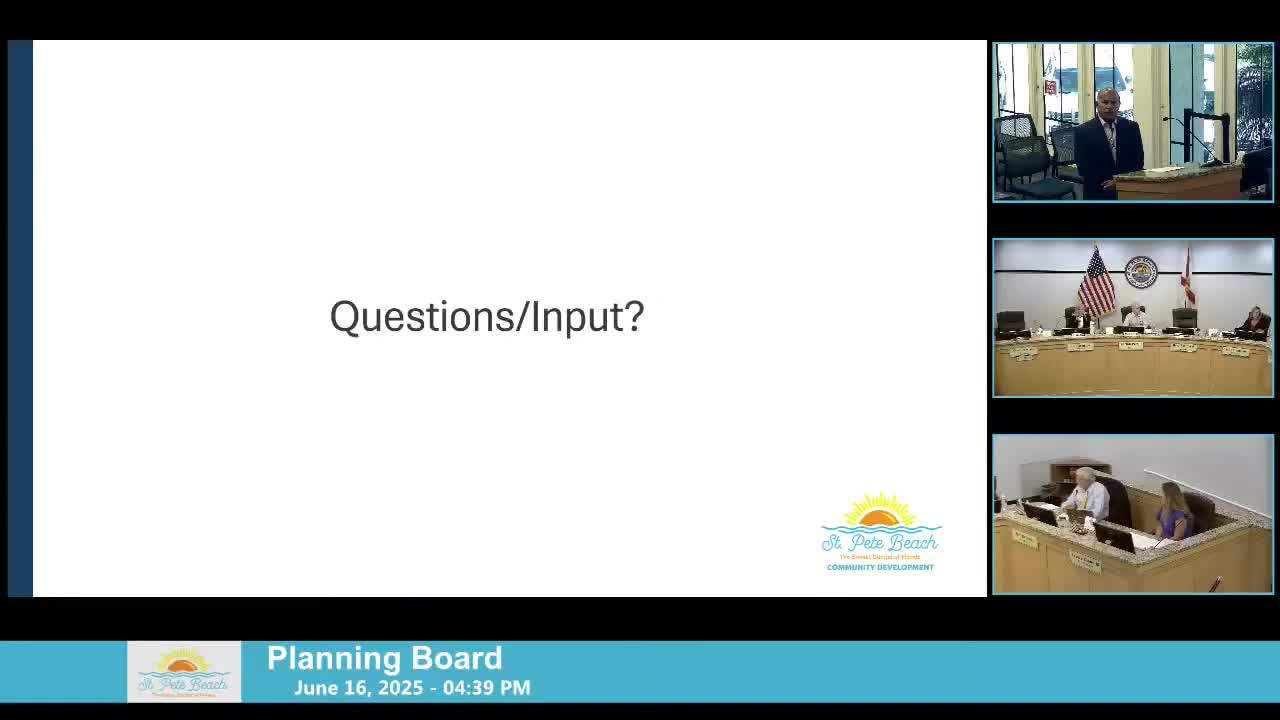St Pete Beach adopts voluntary lighting guidelines for turtle-friendly compliance
June 17, 2025 | St. Pete Beach, Pinellas County, Florida
This article was created by AI summarizing key points discussed. AI makes mistakes, so for full details and context, please refer to the video of the full meeting. Please report any errors so we can fix them. Report an error »

In a recent meeting of the St. Pete Beach Planning Board, discussions centered around the adoption of a voluntary technical guidance model for sea turtle lighting, prompted by Senate Bill 180. This initiative aims to assist property owners in complying with existing lighting regulations that protect local wildlife, particularly sea turtles, from harmful artificial light.
The proposed model lighting ordinance serves as a resource for property owners, providing clear standards on what types of lighting are suitable for compliance. This guidance is intended to simplify the process for residents who may need to replace their outdoor lighting fixtures to avoid violations. The ordinance will not impose new restrictions but will instead offer recommendations to help property owners make informed choices about lighting that minimizes visibility to turtles.
Code Enforcement Manager Pete Duerer highlighted the effectiveness of the current code, which has already been used to cite violators. He explained that the existing regulations allow for enforcement without requiring significant changes, although there is potential for amendments to improve compliance further. The board discussed the use of a specialized card that helps determine whether a property’s lighting is in violation, emphasizing the importance of using technology to ensure compliance.
The board also addressed the implications of Senate Bill 180 on development permits and conditional use permits. It was noted that while the bill introduces certain limitations, developers can still negotiate higher compliance standards voluntarily as part of their project approvals. This flexibility allows for tailored solutions that can enhance environmental protections while accommodating development needs.
As the city moves forward with these discussions, the focus remains on balancing community development with the preservation of local wildlife. The voluntary guidance model is seen as a proactive step in fostering compliance and promoting responsible property management, ultimately benefiting both residents and the environment. The Planning Board will continue to refine these guidelines, ensuring they remain relevant as technology and regulations evolve.
The proposed model lighting ordinance serves as a resource for property owners, providing clear standards on what types of lighting are suitable for compliance. This guidance is intended to simplify the process for residents who may need to replace their outdoor lighting fixtures to avoid violations. The ordinance will not impose new restrictions but will instead offer recommendations to help property owners make informed choices about lighting that minimizes visibility to turtles.
Code Enforcement Manager Pete Duerer highlighted the effectiveness of the current code, which has already been used to cite violators. He explained that the existing regulations allow for enforcement without requiring significant changes, although there is potential for amendments to improve compliance further. The board discussed the use of a specialized card that helps determine whether a property’s lighting is in violation, emphasizing the importance of using technology to ensure compliance.
The board also addressed the implications of Senate Bill 180 on development permits and conditional use permits. It was noted that while the bill introduces certain limitations, developers can still negotiate higher compliance standards voluntarily as part of their project approvals. This flexibility allows for tailored solutions that can enhance environmental protections while accommodating development needs.
As the city moves forward with these discussions, the focus remains on balancing community development with the preservation of local wildlife. The voluntary guidance model is seen as a proactive step in fostering compliance and promoting responsible property management, ultimately benefiting both residents and the environment. The Planning Board will continue to refine these guidelines, ensuring they remain relevant as technology and regulations evolve.
View full meeting
This article is based on a recent meeting—watch the full video and explore the complete transcript for deeper insights into the discussion.
View full meeting